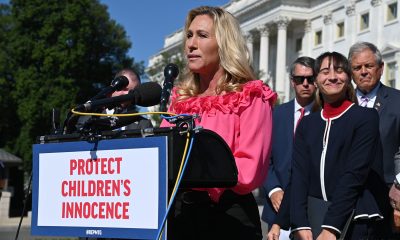a&e features
‘Unique’-ly Alex
Out singer on ‘Glee,’ Pride, Beyonce and more

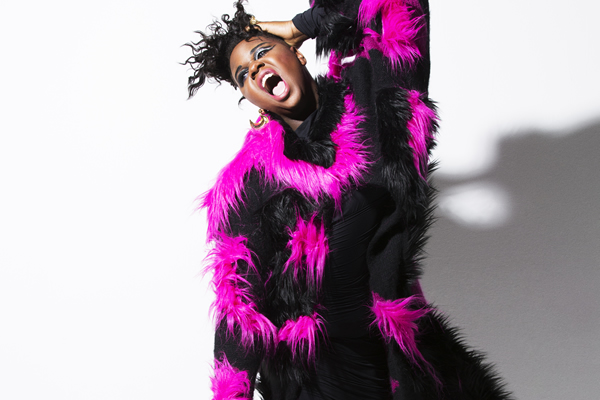
Alex Newell of ‘Glee’ fame says Pride is important because it gives the LGBT community a place to celebrate its accomplishments. (Photo by Brian Ziff)
Singer/actor Alex Newell, best known for playing Unique on “Glee,” is one of this year’s headliners on the Capitol Concert Stage at Capital Pride this weekend.
Look for him in the 2 p.m. slot where he’ll showcase his soaring, buttery vocals. We caught up with the soft-spoken, yet outspoken, 23-year-old performer by phone from Los Angeles.
BLADE: You have a new song out?
NEWELL: Well right now I’m kind of doing the Pride circuit. It’s Pride month, Pride season. I also have a new song out today called “Need Somebody.” It just came out. This first week, we’re donating a portion of the sales to the Trevor Project.
BLADE: Who produced it?
NEWELL: Cutfather. He’s amazing.
BLADE: You had an EP (“Power”) out earlier this year. Do you plan more?
NEWELL: It depends. We’re just trying to see. There’s no set plan. I think we’re going to do another, but this is just its own thing. We’re focusing on making new music and making good songs. The EP was so good and everyone enjoyed it and it was successful so now we’re just trying to match that or go above and beyond it.
BLADE: How many Prides are you doing?
NEWELL: I don’t know. Maybe four, five or six. I don’t like to count them because then it starts to feel overwhelming.
BLADE: Why is Pride important?
NEWELL: It’s a time to celebrate each other and the accomplishments in our community. Because that’s where it starts. It always starts at home. If we don’t celebrate each other and where we are, it just gets kind of superfluous after a while.
BLADE: You toured with Adam Lambert earlier this year and played Washington in March. How was it?
NEWELL: It was amazing. I went on tour with one of my good friends. I had fun. I couldn’t have asked for a better time. We played D.C. right after New York. The audience was warm and responsive and welcoming. It was a good time.
BLADE: What was it like on the “Glee” set? Fun and hanging out or nerve-wracking and hard? All of the above?
NEWELL: It was very friendly like a giant family. It’s basically like a household. It’s dysfunctional, it’s functional. And at the same time you’re working 16-hour days a lot of the time and you’re with each other five days out of the week and sometimes more than that because we’re friends at the end of the day. And you’re trying to make the best product you can whether you’re singing, dancing, acting or having dance rehearsals and makeup tests and filming scenes or filming a music number or having a fitting or going to pre-record the song. There’s so many variables to it so it was just as crazy as anyone would think it was. But at the end of the day, we were all there together and we were just working at a well-oiled machine.
BLADE: Which “Glee” episode was your favorite?
NEWELL: I don’t know. They started to blur together after a while. Like sometimes I’ll forget what I did in each episode. I think one of my favorites would have to be my second-to-last one where I sang “I Know Where I’ve Been” with the trans chorus. It was just a good moment to have everyone rally. I also really liked the “Grease” episode. I felt that one has so much heart.
BLADE: Was (creator/executive producer) Ryan Murphy around a lot?
NEWELL: Yeah, we saw him all the time. He was there as much as someone who has three shows on TV is there. It’s not like he’d be there everyday all the time because he had “Glee” and “American Horror Story,” and then one year he had “Glee,” “American Horror Story” and “The New Normal” on TV at the same time. Then “The New Normal” got canceled and he had “American Horror Story,” “Glee” and he was developing “Scream Queens” and “American Crime Story.” So I feel like the show runner doesn’t always have to be there but his ear was to the ground. He knew what was going on the entire time.
BLADE: Was he approachable?
NEWELL: Oh yeah. He was amazing. He’s so sweet and kind. He’s very intelligent. He’s smart and every time he greeted me, he gave me a warm hug. He’s known me since I was like 17, 18. He’s watched me grow, not just as an actor but as a performer. He’s always very welcoming and warm.
BLADE: Were you and Chris Colfer (Kurt) especially friendly?
NEWELL: I love him dearly. I don’t want to judge it based on other friendships I may have, but we were very friendly.
BLADE: You got really famous really fast at something really specific. How hard has it been trying to funnel that momentum into other things you want to do?
NEWELL: Well, it’s always hard and difficult when you’re coming off playing a specific thing and a role on such a large scale because after a while, that’s all people can see you for. You kind of have to prove yourself on another scale. A lot of people say, “Well, they pre-recorded on ‘Glee,’ none of them are really singers,” but in actuality, the majority of us were actual wingers and we’ve honed our craft and all. But there’s always that thing of trying to prove myself even more than just being a TV actor or a TV personality. That I’m actually talented and that I can do other things than play that specific role. But this is not exactly news to anyone. It happened to lots of child stars. When they grew up, it was always hard for them to be seen as anything other than the role they’d been playing.
BLADE: I know you can’t quantify this exactly, but how much of what you’ve achieved has been talent vs. perspiration?
NEWELL: I feel like it’s an even balance. I work extremely hard for everything that I have and everything that I’ve gotten. Where I’ve been, I’ve fought tooth and nail and just as much as anyone else if not harder. You have to know that you’re amazing and not get complacent. You have to remind yourself that you’re the best at what you do and it’s always good to know that no one else can do exactly what you do. They can do it like you, but they can never do it exactly like you do it. You bring something special to the table.
BLADE: You’ve said you’re a big Beyonce fan. How do you like “Lemonade”?
NEWELL: Oh, it’s amazing. It’s honest, it’s truthful and something we haven’t seen. I hear some people wishing the old Beyonce was back but after a while, you have to evolve. You have to go places and I mean, old Beyonce, new Beyonce, Beyonce is Beyonce. I live for her.
BLADE: How do you feel she stands up to classic divas like Donna Summer or Diana Ross? Like when Miss Ross was at her commercial peak with “Upside Down” and “I’m Coming Out” and all that, is Beyonce’s stuff in that league?
NEWELL: I think it’s like a whole other thing. It’s completely different. It’s apples and oranges or like comparing the Civil War to the Cold War. They happened in completely different times. I think too often people want to compare people to the past when they did it on their own and made something their own out of nothing. So I’m not a huge person about comparing things. And with all the changes that have happened in the industry since then, I feel sometimes we have to fight more now because there’s so much that goes on with pirating and not selling, so you end up working even harder. It was easier back in the ‘60s, ‘70s and ‘80s because the only way you got it back then was if you went to the store and physically picked it up. The game has changed so much, it’s hard to even start to compare.
BLADE: Name someone who you’d just be beside yourself if she put out a new record.
NEWELL: Chaka Khan. She hasn’t done anything in so long. I feel like everyone’s kind of reinventing themselves. Barbra’s going back on tour. Cher went back. It’s like everyone’s kind of reinventing themselves saying, “I’m still here, I can still kick your ass.” I’d be shocked if one of them came out with something new, honestly.
BLADE: What do you have planned for your Pride set?
NEWELL: I’m going to do some new things, I’m going to do some old things, I’m going to do some “Glee” things. I think it’s going to be like 30-40 minutes. It’s just gonna be fun. When I do a show I like to reflect. I feel like reflection’s always really nice and just to the obvious of what people expect you to do.
BLADE: I know they’re totally different from your role on “Glee,” but do you feel any connection with shows like “Transparent” or “I Am Cait” or keep up with them?
NEWELL: I do. I’m always for representation because for the longest of time, there weren’t many people on TV who looked like me. Obviously I’m African American, and for the longest time after the ‘90s, after shows like “Fresh Prince of Bel-Air” and “Family Matters” and “Hangin’ With Mr. Cooper” went off the air, it felt like everything got very whitewashed. So not only was my race not represented, my sexual orientation wasn’t either. I imagine millions of other people felt the same way. So I will always stand up for the trans community because I know what it feels like to be that person who has no representation. Laverne (Cox) is one of my good friends. We have lunch and talk and text. We’re good. I’m always there for it.
BLADE: How do you feel about this North Carolina stuff with House Bill 2?
NEWELL: It’s just people trying to control others. It’s basically a dumbed-down version of segregation like having a blacks-only entrance and a whites-only entrance. People are trying to get rid of something they don’t like just because they don’t understand it. I feel like it’s just too much. Like when Stacey Dash said they should just go pee in the bushes. I’m like, “I’m pretty sure your ancestors were being hung from trees just like the rest of us, so why would you say something as inhumane as that?”
BLADE: Is this the tipping point for the transgender movement?
NEWELL: I can’t really speak to that. I think it’s a catapulting movement where this could really put the limelight on things, but is this the start of the avalanche going down? I just don’t know. I don’t know if this is the last straw, but it’s poking at that bear.
BLADE: You identify as gay but you’re so heavily identified with a transgender role. Does that ever get weird or are you OK with it?
NEWELL: I get mistaken as trans all the time and it’s something I’m fine with and welcome it only because it means my role was so important in helping or it means I did a good job with it at the end of the day. It’s something I stand for and something I represent and I want to be a voice with, so it’s fine. I mean, I’ll correct someone, but ti’s OK. When I’m back in Boston with my mom and we go out to dinner, they’ll often say, “And how are you ladies doing?” My mom’s like, “I don’t see a lady,” and I’m like, “I don’t either,” but most people do. I have a very effeminate face and I have long hair and I’m extremely gay, so it happens. I haven’t really heard anything negative, like somebody saying I’m pretending to be something I’m not. I haven’t experienced that.
BLADE: Is there any song you remember from growing up singing in church that has stayed with you?
NEWELL: I used to sing a song called “Give Me a Clean Heart.” Sometimes I hum it and when I go back to church, it’s always the song they want to hear. So that’s kind of followed me my entire career.
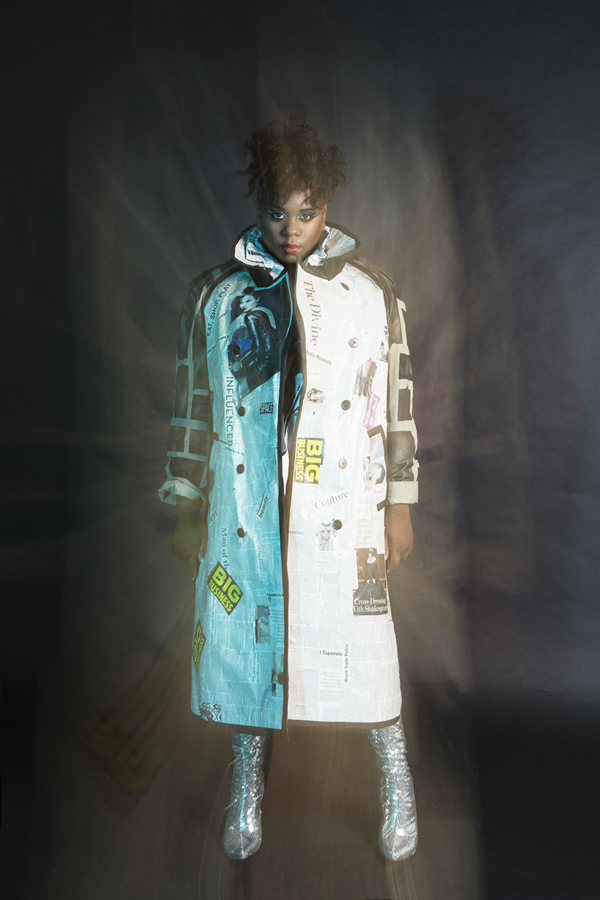
Out actor Alex Newell says he doesn’t mind getting mistaken for being transgender. (Photo by Brian Ziff)
a&e features
Local, last-minute holiday gift ideas
Celebrate the season while supporting area businesses
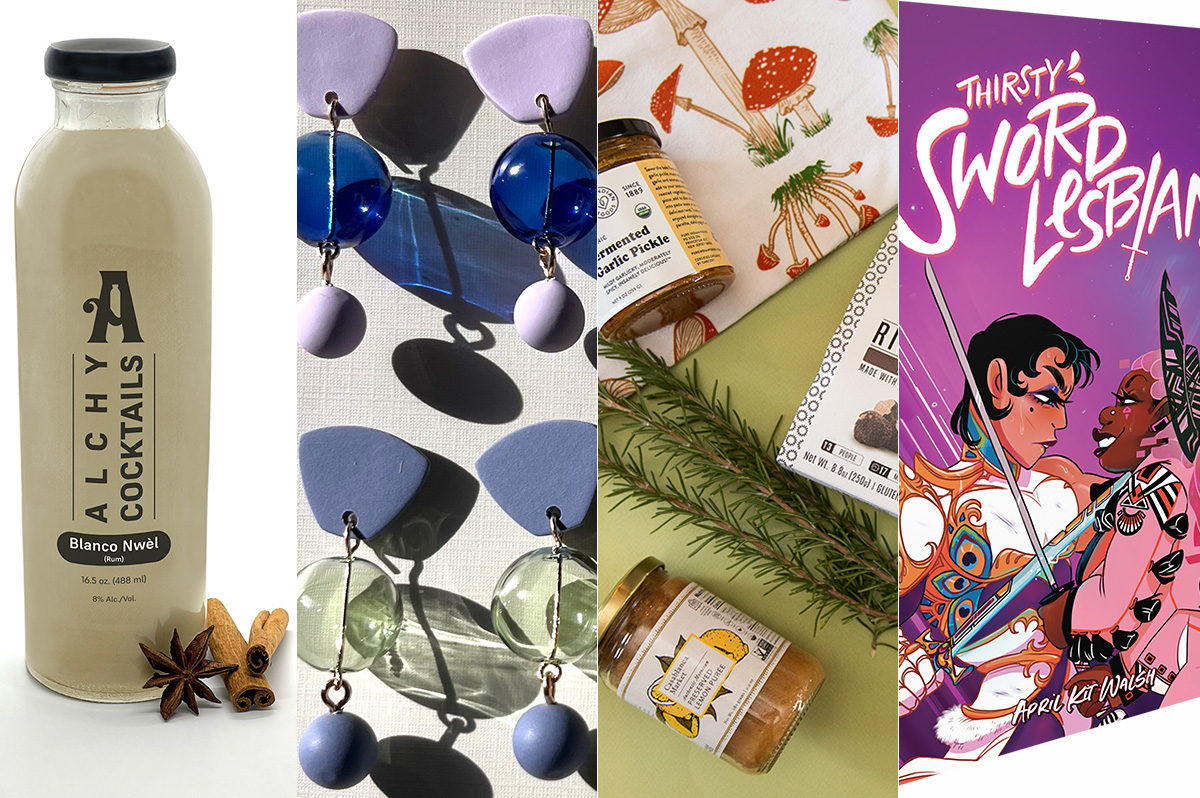
The DowntownDC Holiday Market is bustling. Union Station is decked out with its annual Christmas tree. Washingtonians have wrapped their houses and apartment balconies with festive lights and holiday decorations. The holiday season is here. And with stockings to fill and empty space under the tree, Washington’s local shops and artists have plenty to offer.
Show your LGBTQ and D.C. pride with the Washington Blade’s annual holiday gift guide.
To embrace the holiday buzz: The Blanco Nwèl cocktail from Alchy Cocktails. This Caribbean eggnog is one of Alchy Cocktail’s seasonal holiday cocktails. The flavor profile is similar to coquito, a traditional Puerto Rican Christmas drink with a coconut base. As a queer and Caribbean-owned business, Alchy Cocktails has been based out of Washington since 2021. Blanco Nwèl is available in both cocktail ($24) and mocktail ($12) online and at a variety of holiday markets, including the Tingey Plaza Holiday Market, the Flea Market at Eastern Market, Union Station’s Main Hall Holiday Market, and more. ($24)
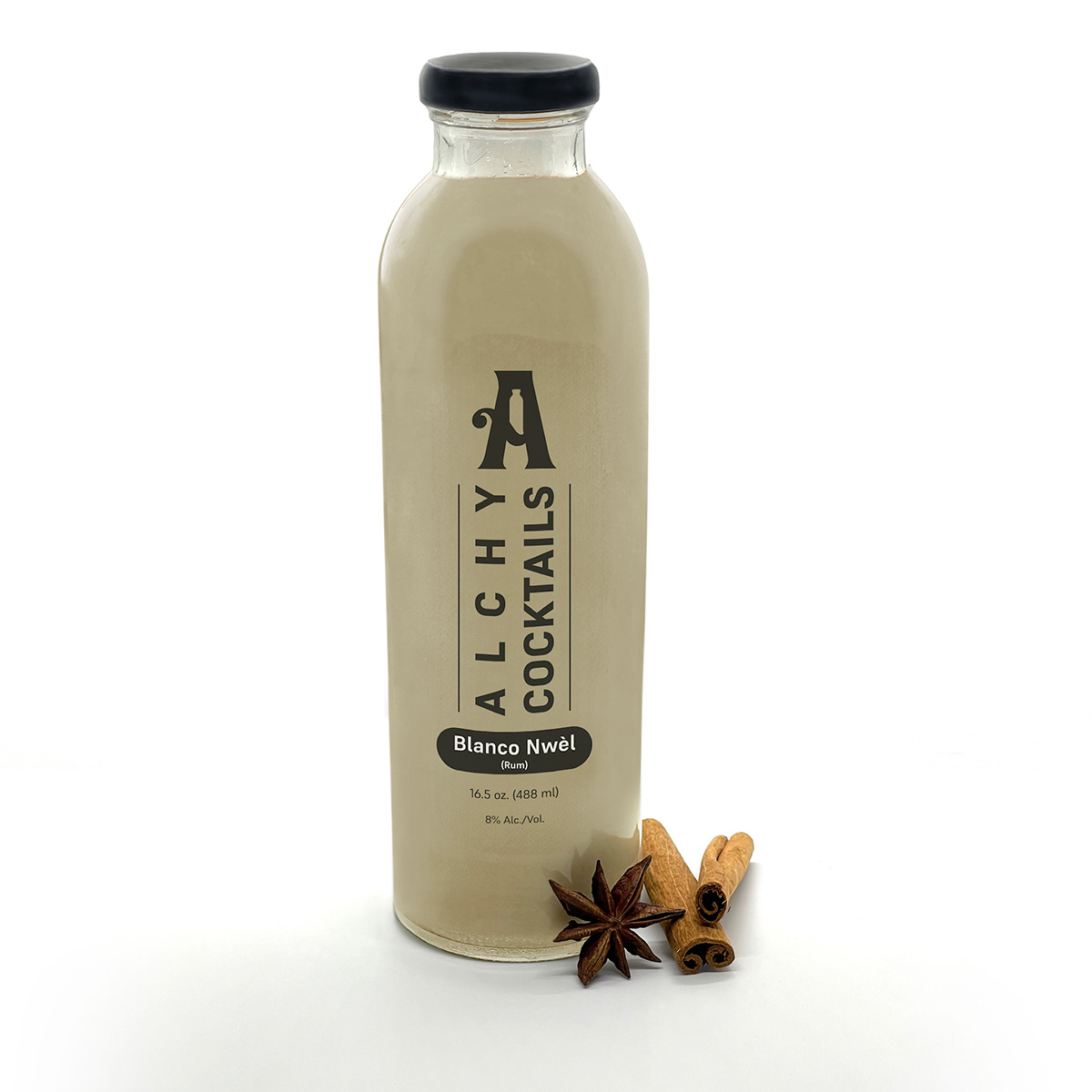
A spicy bite: Gordy’s Cajun Okra from Salt and Sundry. These spicy, tangy pickles pull on Southern Cajun-style flavors, packing a punch with paprika, cayenne, and more. Gordy’s is an LGBTQ-owned and Washington-based brand, making this gift an opportunity to support a local LGBTQ business straight from the jar. This pantry staple is available on Salt & Sundry’s website and at its locations in Union Market, Logan Circle, and its Georgetown holiday pop-up store. ($14)
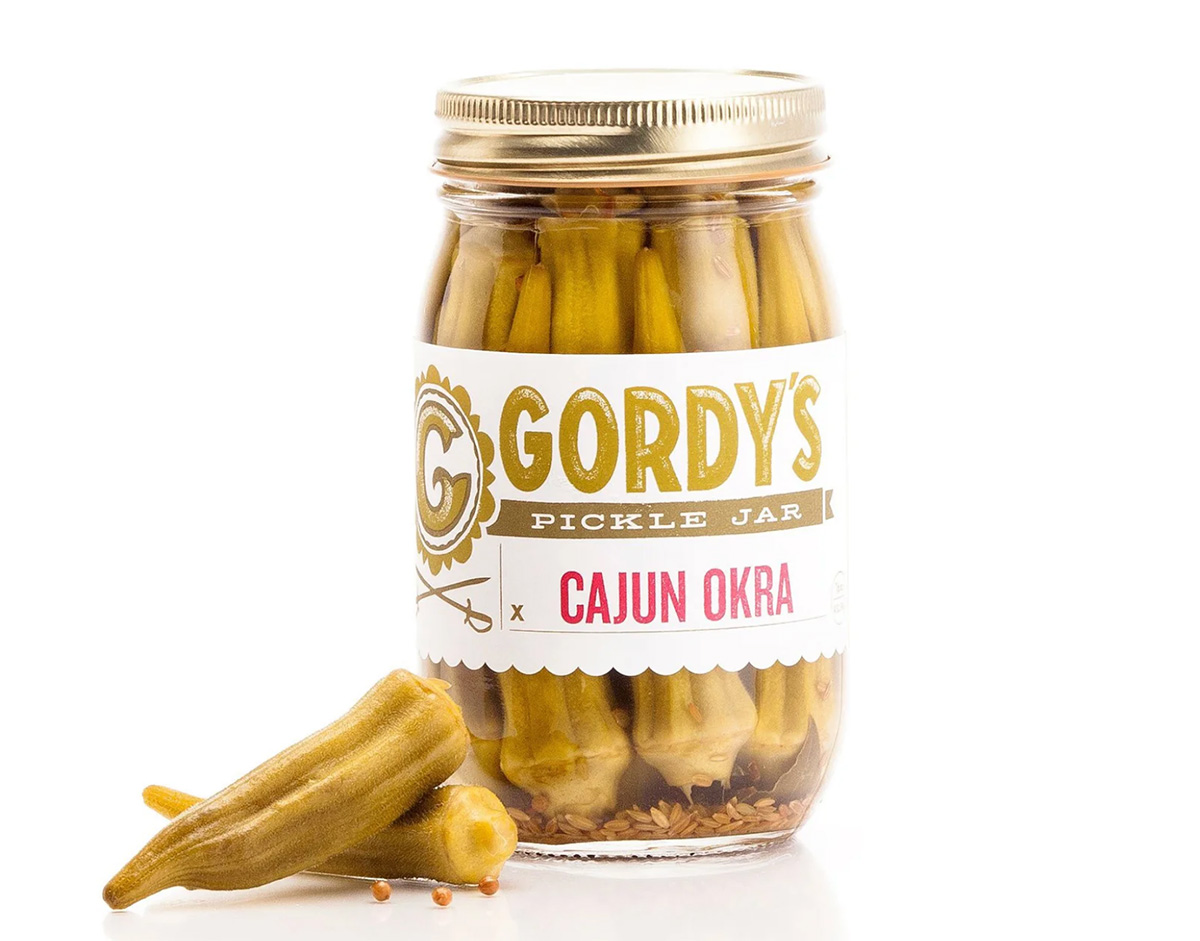
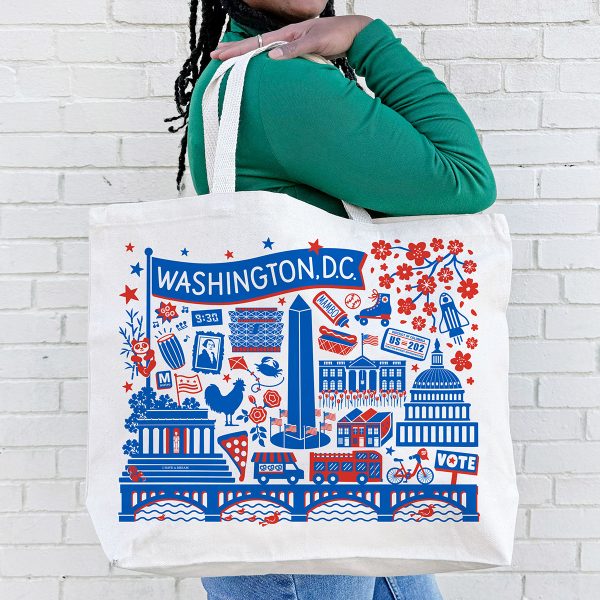
To celebrate Washington pride: The DC Landmark Tote Bag from The Neighborgoods. Native Washingtonians, visitors, friends and family alike will find something to love about this Washington-themed tote bag. Food trucks, the 9:30 Club, the Metro logo and pandas from the National Zoo are just some of the city’s landmarks depicted across the tote in a red, white, and blue color palette. The tote is a part of the DC Landmarks collection, which donates 10 percent of its sales to the American Civil Liberties Union. The Neighborgoods itself is a local, woman-owned business built out of a passion for screen-printing in 2013. The 100 percent cotton canvas tote is for sale online or at the DowntownDC Holiday Market. ($22)
To give friends and family their flowers: The Flowers Bandana from All Very Goods. This 100 percent cotton bandana was designed in Washington and hand printed in India. Its uniqueness comes in being covered with the faces of Black women, representing a “love letter to all women but especially Black women,” according to All Very Goods. The Black woman-owned and operated business, based out of Northwest Washington, has a mission to celebrate diversity and representation through its products. The bandana intends to give Black women their “flowers.” The Flowers bandana is available for purchase online. ($24)

To unlock culinary creativity: The Curious Chef Gift Collection from Each Peach Market. This customizable collection of kitchen oddities — ranging from tinned fish to chili oil — is a quirky gift for the most inventive chefs. The collection is available in a Standard Santa, Extra Goodies and Super Holiday Size for up to $165. The Washington-based market, founded in 2013, permits customers to make the collection special by specifying what unique ingredients are packaged, including products made by local or LGBTQ brands. Each Peach Market offers assembly and pick up in-person at its Mount Pleasant shop and also offers local delivery and nationwide shipping via its website. ($85)
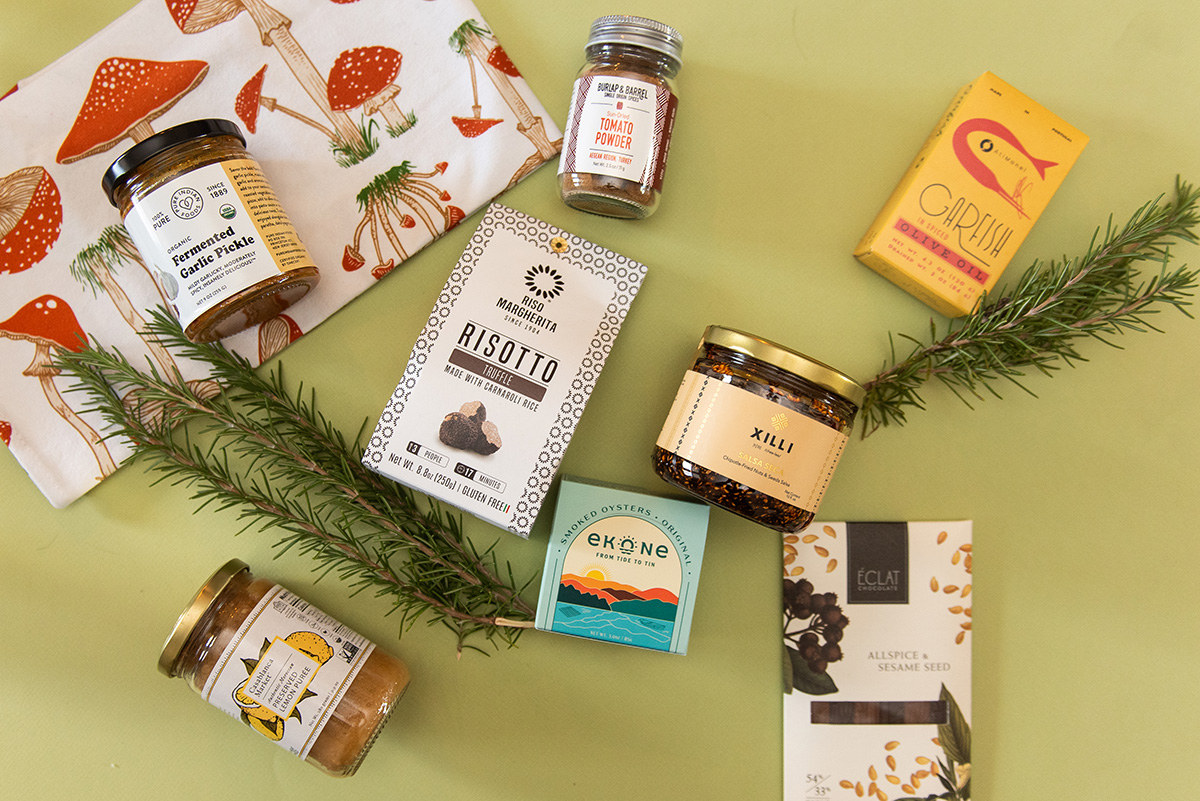
To give a touch of sweetness: The DC Landmark Chocolate Covered Oreo Holiday Cookies from Capital Candy Jar. Wrapped in a festive red bow, this box of nine cookies embraces love for Washington and the holiday season in one. Among the dark and milk chocolate covered cookies are images of the U.S. Capitol, the White House, the Lincoln Memorial, the Jefferson Memorial and festive hollies. The treat, packaged in a Hill East facility just a few blocks from the Capitol, is available for purchase online and at the DowntownDC Holiday Market. ($23.95)
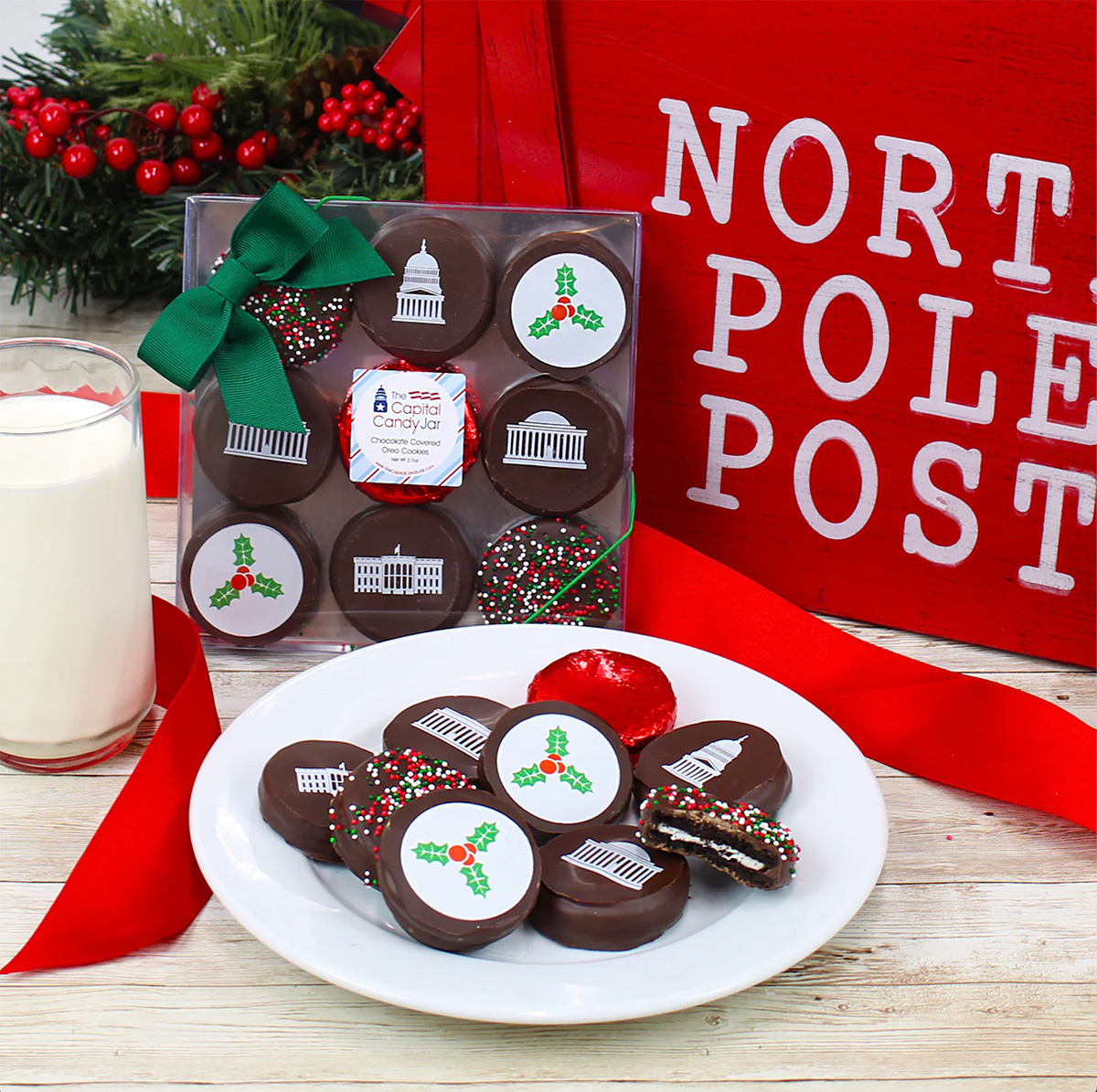
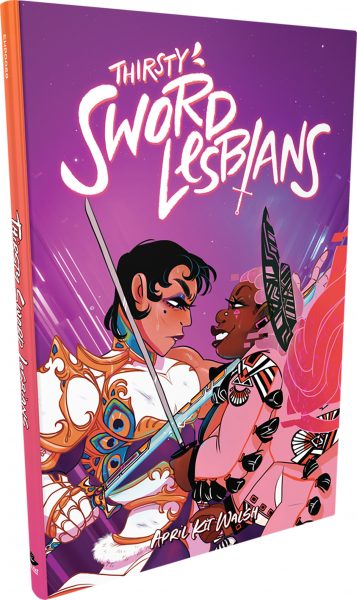
To celebrate queer gaming: Thirsty Sword Lesbians from Labyrinth Games & Puzzles. This roleplaying game embraces lesbian culture by unlocking a world of swords, romance, and battle. Ideal for group settings, the book presents a system of world building and character identities that are best brought to life by creative minds. Labyrinth, which has been a local Washington business for more than 15 years, celebrates non-digital fun through games and puzzles that connect the community. This gift is offered online and at Labyrinth’s Capitol Hill location. ($29.99)
To make a bold statement: The “Resist” T-shirt from Propper Topper. This locally screen-printed black tee features the Washington flag designed within a raised fist, symbolizing both Washington pride, and political resistance. The shirt is made exclusively by Propper Topper, a local Washington business that evolved from a hat shop to a gift store since opening in 1990. The tri-blend unisex shirt is available both for pickup at Propper Topper’s Cathedral Heights location and shipping via the online site. ($32)
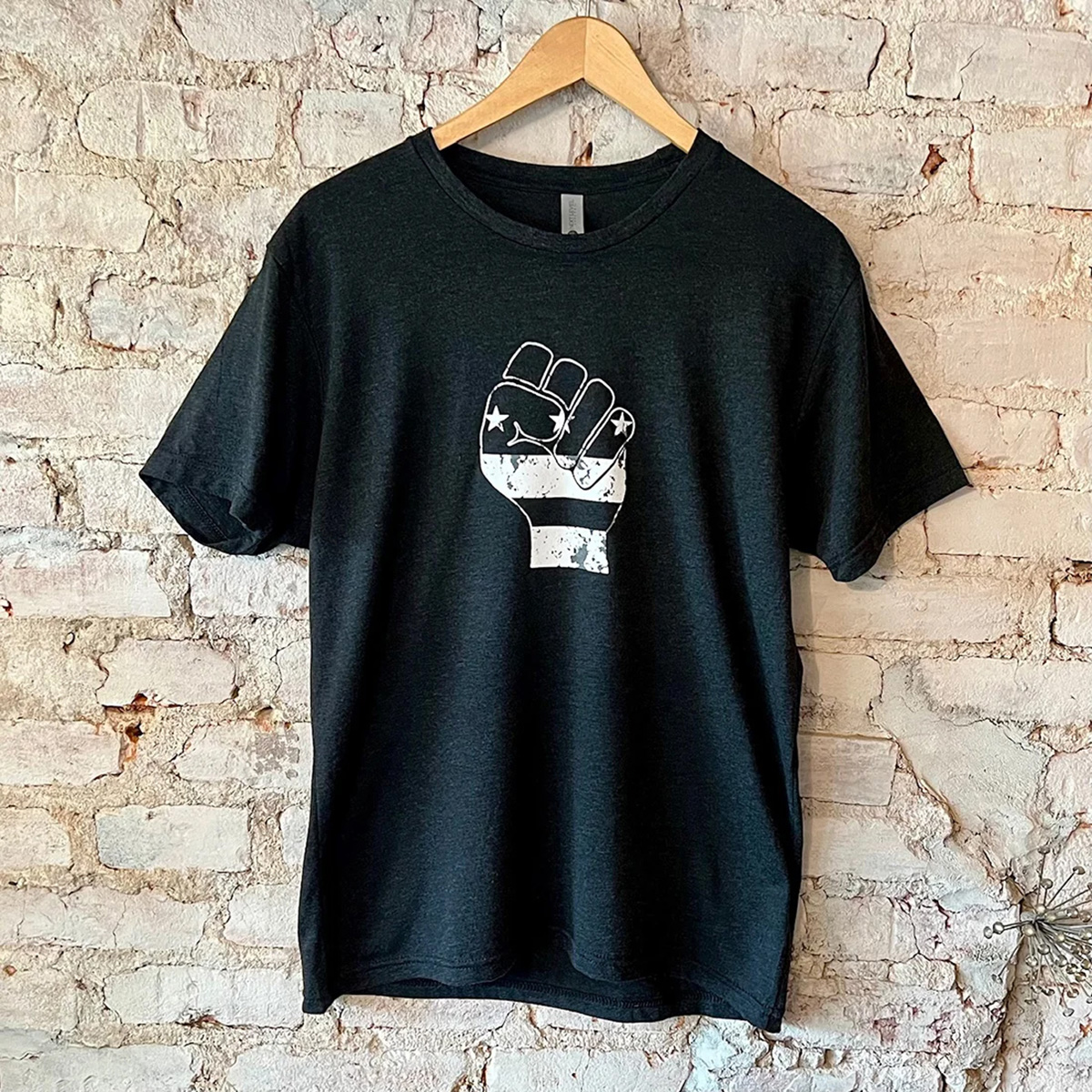
To keep it c(g)lassy: The Glass Ball earrings from Blue Moon Aquarius. Gifting can rarely go wrong when it comes to a new pair of earrings. The unique statement earrings — made of polymer clay, glass, and 18k gold plating over surgical steel — are hand cut, sanded and assembled in Washington, meaning each set is unique. Blue Moon Aquarius, a local brand, is known for its small batch jewelry and home decor designed with clay materials. Available in oxblood, hunter green, lavender, and bluestone color palettes, these earrings are available for purchase on Blue Moon Aquarius’ website and at the DowntownDC Holiday Market. ($48)
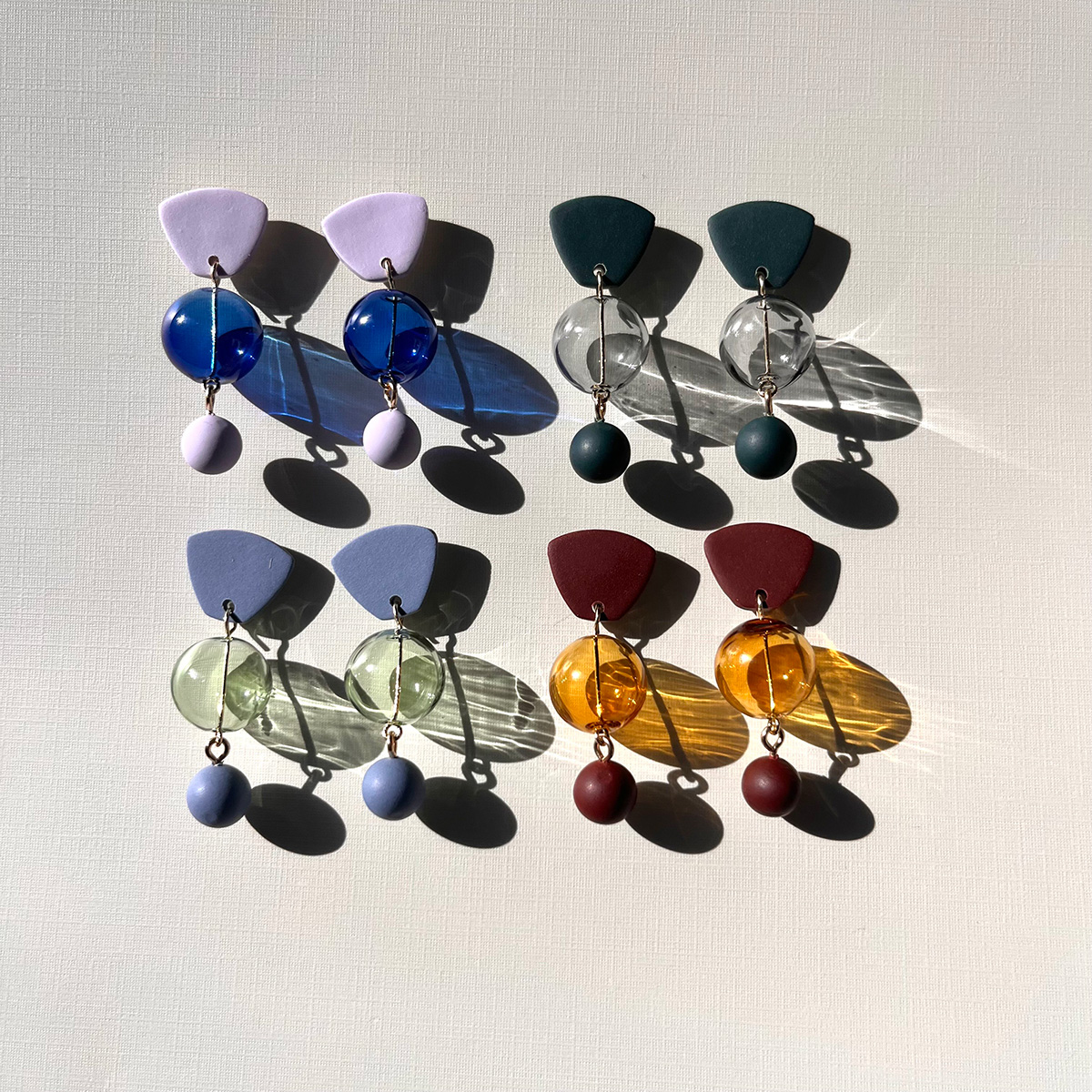
To elevate a holiday tea or charcuterie party: The Honey Flight: Tea Lover’s Selection from BannerBee. This local honey company presents the ideal gift to make cozying up with a cup of tea slightly more special. The Honey Flight contains three types of raw wildflower honey infused with fair trade Ugandan vanilla bean, chai spices, and locally sourced lemon thyme herb. The gift is also an opportunity to uplift a family company based in the Mid-Atlantic that offers all-natural, sustainable products. The flight is available online, at the DowntownDC Holiday Market or at the Arlington Courthouse and Dupont Farmers’ Markets. ($36)
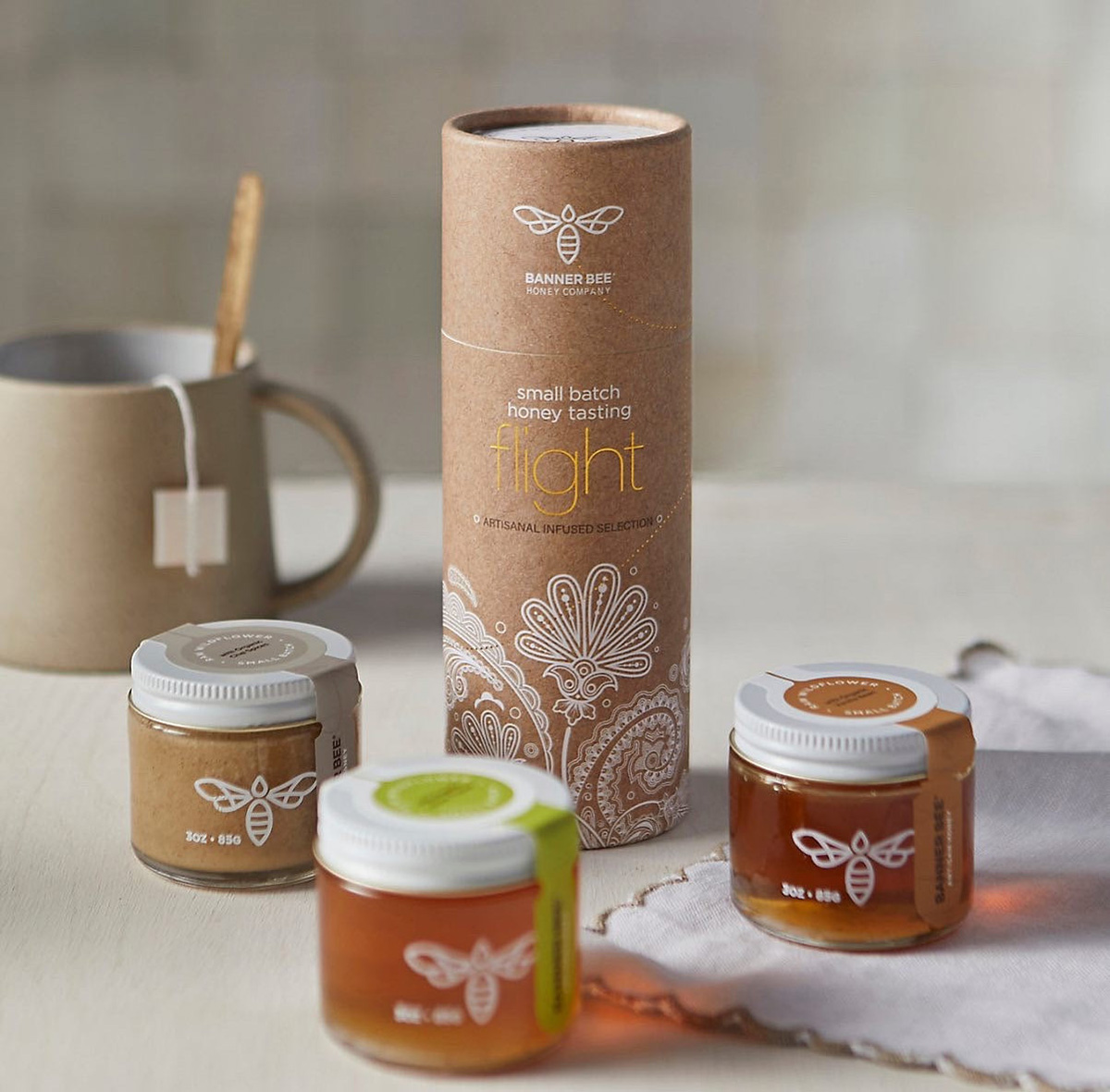
For Baltimore shoppers: If you’re in Charm City, don’t miss Balston Mercantile, opened by a gay couple in June. Their gorgeous shop in the Hampden neighborhood offers an array of unique, upscale finds, from barware and artwork to cookbooks and home decor and more. (849 W. 36th St.)
a&e features
Have yourself a merry John Waters Christmas
Annual holiday show returns to Alexandria and Baltimore
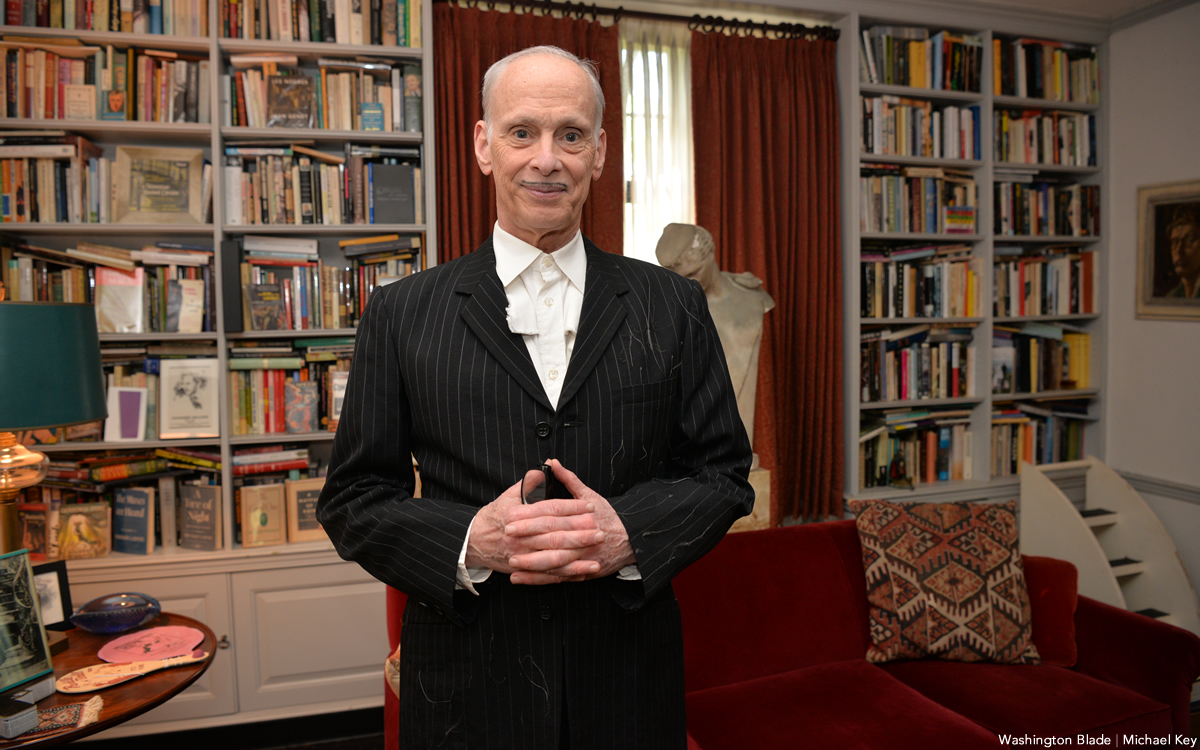
When it comes to iconic Christmas scenes in movies, none can top the tree-toppling tantrum thrown by cha-cha heels-deprived Dawn Davenport in John Waters’s fifth full-length feature “Female Trouble” from 1974. Therefore, it’s not surprising that Waters continues to make art out of Christmas, performing his spoken word Christmas tour in cities across the country. Waters has even more reason to celebrate with the release of his new red vinyl 7” single, a cover of Little Cindy’s “Happy Birthday Jesus (A Child’s Prayer)” on the A-side, and “A Pig Latin Visit From St. Nicholas” on the B-side. If you’re still looking for unique Christmas gifts, consider this record. As always, John was kind enough to make time for an interview in advance of his tour dates.
BLADE: John, in preparation for this interview with you, I went back and listened to Little Cindy’s original rendition of “Happy Birthday Jesus (A Child’s Prayer)” on your “A John Waters Christmas” CD.
JOHN WATERS: One thing I did, if you notice, I make the same stumble in my recording that she did in the original.
BLADE: It sounded to me like she got choked up.
WATERS: No, I think she just stumbles over a word, so I stumbled over the same word. It’s appropriation, insanely.
BLADE: Is this a song you first became aware of in your youth or when you were an adult?
WATERS: When I was doing the Christmas album, I had this friend named Larry Benicewicz. He was kind of my idea man with music. He knew every single old record. I would say to him, “Weird Christmas songs,” when we were doing a soundtrack, or a song about bears, or a song about this, and he would give me all these tapes. It was one of the ones he played for me. A lot of the songs I put in my movies and on my records, I did know as a kid. I did not know this one, but I immediately embraced it. I don’t think it’s campy. I think it really is spiritual in a weird way. My doing it makes it a novelty record. I am really for novelty records, and there aren’t any anymore. Why was there not a COVID novelty record? That’s insane. The dance “The Bug” that’s on the “Hairspray” soundtrack would be perfect for COVID.
BLADE: The thing that struck me was that for a Christmas song in the voice of a child, a kind of death pall hangs over it, with lines like, “If I was good you’d let me live with you” and “they nailed you to the cross, they wanted you to die.”
WATERS: All of it! When I see children at midnight mass kneeling in front of a nude man nailed to a cross, I feel like I’m at The Eagle! It is S&M, it’s creepy. I took the same cover (photo) from her record to parody and put my face on it. The same thing I did with The Singing Dogs last year when I covered (their version of) “Jingle Bells.” I’m really into novelty records. I love them and I’m trying to bring them back. I don’t expect anybody to ever play these records. Even The Singing Dogs one said on it, “Please do not play this record” [laughs]. And the flipside, the Pig Latin version, is almost impossible to listen to.
BLADE: I’m so glad you mentioned that. “A Pig Latin Visit From St. Nicholas” reminded me of the lost art of speaking in Pig Latin. I also recall watching the PBS series “Zoom” as an adolescent and learning to speak “ubbi dubbi,” a distant relative of Pig Latin. Do you think that the time is right for a Pig Latin or ubbi dubbi revival?
WATERS: Here’s the thing, I never could pick up any language, except Pig Latin. I’ve been in every foreign country. Foreign countries have given me money to learn to speak the language. I can never do it! But Pig Latin…my parents and other parents in the ‘50s spoke Pig Latin so kids couldn’t understand what they were saying. Then my mother taught it to me, and I used it. The hardest take to shoot in “Pink Flamingos” was not eating the dog shit. It was when the cast skipped, in one take, saying “E-way, are-yay e-they ilthiest-fay eople-pay in-hay e-they ole-hay ide-way orld-way.” We’re the filthiest people in the whole wide world in Pig Latin. We had to do so many takes so they could do it once without screwing it up. In “Polyester,” Edith (Massey) answers the phone, “ello-hay.” I did a photo piece where it was all subtitled in Pig Latin. Like “osebud-Ray” (from “Citizen Kane”) or in “Streetcar,” “ella-Stay!” [Laughs] All the iconic dialogue translated into Pig Latin. My assistant who helped me do it, had never heard of Pig Latin. She really got good at it because she lived in many foreign countries and can pick up languages. But it’s not that easy to do it correctly and read it. Your computer will translate into Pig Latin.
BLADE: AI understands Pig Latin?
WATERS: I guess that’s AI. It wasn’t 100% right, but it was close. I can speak it if I look at it, but just do a bit at a time. It was a challenge that no one would possibly care about or want to do.
BLADE: I think you pulled it off very well.
WATERS: If you want people to leave on Christmas morning, you put it on. That’s how you get your guests to leave. It’s time to go.
BLADE: Ood-gay i-bay! How did your relationship with record label Sub Pop, which released 2021, 2022, 2024, and new 2025 holiday singles, come about?
WATERS: I believe the first thing I did for them was “Prayer to Pasolini.” They came to me through Ian Brennan. He’s won a couple Grammys for World Music, but he is also is one of my agents who does the Christmas tour and a lot of my shows, anything with music. He helped me arrange each one of the songs. He had a relationship with Sub Pop. It was perfect. My friends in Baltimore, (the band) Beach House, have had huge success.
BLADE: That’s right, they’re on Sub Pop!
WATERS: Yes! I’m happy to be on it. I’ve even been to the warehouse and posed for pictures like Jackie Suzanne used to do.
BLADE: Is there any chance that “A John Waters Christmas” might be reissued on vinyl by Sub Pop?
WATERS: No. It’s such a nightmare to get the rights and to renew them. You have to find the publisher and the writer, and they usually hate each other. It doesn’t matter if it’s obscure or famous, it’s hard to get. You have to make the deal. The singer doesn’t get anything unless they play it on the radio. It would be so complicated legally, and there would be such a [laughs] tiny audience for it. I hope it will come out again. The same thing with the one for Valentine’s Day. I had two of them that did quite well when they came out; “A Date With John Waters and “A John Waters Christmas.” The “John Waters Christmas” album is still the soundtrack that plays whenever I’m doing my spoken word Christmas show as people are entering the theater.
BLADE: Aside from your annual Christmas show tour, what else do you do for the holidays now, and are there any traditions that you’ve carried over from your family?
WATERS: Certainly! I have two sisters, my brother’s widow, and me, so there are four and we take turns each year to have the Christmas dinner. Mine was last year. An entire sit-down dinner. Mom’s China, the silverware, the entire full dinner. It’s pretty traditional. I don’t have a Christmas tree, but I do decorate the electric chair from “Female Trouble.” That is a tradition in my family. We do have Christmas decorations, but they’re usually weird ones that fans sent me. I have one with Divine knocking over the Christmas tree, and the Christmas tree lights up, all sorts of amazing things. There is definitely a tradition here that might be a little altered, but it is definitely a tradition. I used to have a giant party every year, but COVID ended that. I still wouldn’t want 200 people in my house breathing right now.
BLADE: I was looking at your tour schedule and wondered if there are any new cities in which you’ve never performed the John Waters Christmas show that have been added to this year’s schedule?
WATERS: I don’t think there’s a city in America in which I haven’t done one show! The only places I haven’t been to are Hawaii and Alaska. I could do it there, but it’s too long on a tour. I can’t think of a city I haven’t played in in America over the last 50 years. The Christmas show is completely different every year. It doesn’t matter if you saw it last year.

Some gifts scream practical, others whisper luxury, and a few flat-out blur the lines. From cocoa that feels ceremonial to a cologne that linger like a suggestive smirk, this year’s ultimate gift picks prove that thoughtful (and occasionally naughty) presents don’t have to be prosaic. Welcome to your holiday cheat sheet for festive tangibles that get noticed, remembered, and maybe even result in a peck of gratitude planted under the mistletoe. Consensually, of course.
Amber Glass Champagne Flutes
Pop the champs – but make it vintage. These tulip-shaped stunners in amber-tinted glass bring all the Gatsby vibes without the Jazz-age drama. Whether you’re toasting a milestone or celebrating a Tuesday, their seven-ounce capacities and hand-wash-only care make ‘em as practical as they are pretty. Pair with a thoughtful bottle of bubs and gift with a glittering wink. $18, NantucketLooms.com
Disaster Playbook by Here Comes the Apocalypse
Because the end of the world shouldn’t be a solo act, this spiral-bound guide is your step-by-step roadmap to surviving and thriving when everything else goes sideways, which might be sooner than you think. Packed with checklists, drills, and a healthy dose of humor, it’s like a survival manual written by your most prepared (and slightly snarky) friend. Whether you’re prepping for a zombie apocalypse or, more realistically, REVOLUTION!, this playbook’s got your back. $40, HereComesTheApocalypse.com
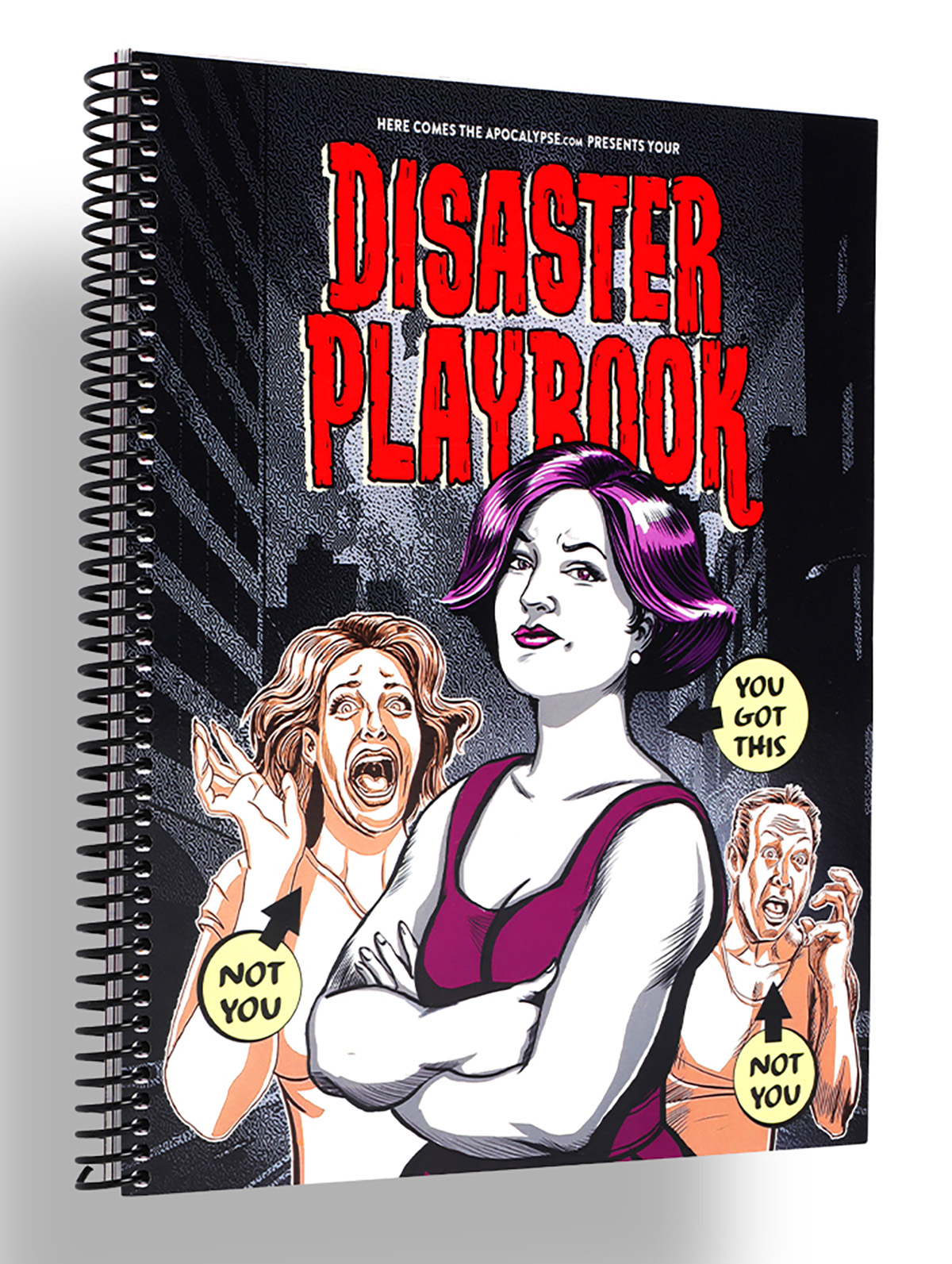
Wickless Vulva Candles
Bold, luxurious, and completely flame-free, CTOAN’s wickless candles melt from beneath on a warmer, releasing subtle, sophisticated fragrances, like sandalwood or lavender. The vulva-shaped wax adds a playful, provocative element to any space –perfect for a bedroom, living room, or anywhere you want elegance with an edge. A gift that celebrates form, intimacy and self-expression, no fire required. $39, CTOANCO.com
Villeroy & Boch Royal Classic Christmas Collection
Every meal is a mini celebration – with whimsy at every place setting – in Villeroy & Boch’s Royal Classic festive dinnerware collection that hits all the right notes. Made from premium German porcelain, it features nostalgic little toys, nutcrackers, and rocking horses in delicate relief, giving your holiday spread a playful but refined twist. Dishwasher- and microwave-safe, it’s luxe without the fuss. Gift a piece to a special someone, or start a collection they’ll use (and show off) for years to come. $22-$363, Villeroy-Boch.com
Greenworks Electric Lawnmower
You a ’hood queen who considers lawn care performance art – or just wants to rule the cul-de-sac in quiet, emission-free glory? Greenworks’ zero-turn electric mower has the muscle of a 24-horsepower gas engine but none of the fumes, drama or maintenance. Six 60V batteries and a 42-inch deck mean you can mow up to two-and-a-half acres on a single charge – then plug in, recharge, and ride again. It’s whisper-quiet, slope-ready, and smooth enough to make you wonder why you ever pushed anything besides your queer agenda. The perfect gift for the homeowner who loves sustainability, symmetry, and showing off their freshly striped yard like that fresh fade you get on Fridays. $5,000, GreenworksTools.com
Molekule Air Purifier
For the friend who treats their space like a sanctuary (or just can’t stand sneezes), the Molekule Air Pro is magic in motion. Covering up to 1,000 square feet, it doesn’t just capture allergens, VOCs, and smoke – it destroys them, leaving your air feeling luxury-clean. FDA-cleared as a Class II medical device, it’s serious science disguised as modern design. Gift it to your city-dwelling, pet-loving, candle-burning friend who likes their living room as pristine as their Instagram feed. $1,015, Molekule.com

Cipriani Prosecco Gift Set
Effervescent with stone-fruit sweetness and a touch of Italian flair, the Cipriani Bellini & Prosecco gift set brings brunch-level glamour to any day of the week. The Bellini blends rich white-peach purée with sparkling wine, while the dry ’secco keeps things crisp and celebratory. Pop a bottle, pour a flute, and suddenly winter weeknights feel like a party – even with your pants off. $36, TotalWine.com
Woo(e)d Cologne
British GQ recently crowned Woo(e)d by ALTAIA the “Best Date Night Fragrance,” and honestly, they nailed it. Confident without being cocky – smoky gaïac and Atlas cedarwood grounds the room while supple leather and spicy cardamom do all the flirting – it’s a scent that lingers like good conversation and soft candlelight. Gift it to the one who always turns heads – or keep it for yourself and let them come to (and then on) you. $255, BeautyHabit.com

Lococo Cocoa Kit
Keep the run-of-the-mill mugs in the cabinet this Christmas and pull out Lococo’s handcrafted Oaxacan versions that demand you slow down and sip like it matters. Paired with a wooden scoop, rechargeable frother, and Lococo’s signature spice hot-chocolate blend (vegan, gluten-free, with adaptogenic mushrooms), this holiday kit turns Mexi-cocoa into a mini ritual you’ll look forward to. Perfect for anyone who loves a little indulgence with a side of ¡A huevo! energy.
Manta Sleep Mask
Total blackout, zero pressure on the eyes, and Bluetooth speakers built right into the straps, this ain’t your mama’s sleep mask — but it could be. The Manta SOUND sleep mask features C-shaped eye cups that block every hint of light while ultra-thin speakers deliver your favorite white noise, meditation, or late-night playlist straight to your ears. With 24-hour battery life, breathable fabric, and easy-to-adjust sound, it turns any bed (or airplane seat) into a five-star sleep suite. Perfect for anyone who treats shut-eye like an art form (or just wants to escape their roommate’s late-night bingin’ and/or bangin’). $159, MantaSleep.com

Shacklelock Necklace
Turn the industrial-chic vibe of a shackle into a sleek statement. Mi Tesoro’s platinum-plated stainless-steel necklace sits on an 18-inch wheat chain, featuring a shackle-style latch pendant that’s waterproof, tarnish-free, and totally fuss-les. Beyond style, it nods to a classic gesture in the queer leather community: replacing a traditional Master lock with something elegant to quietly signal belonging to someone special. Wear it solo for a minimalist edge or layer it like you mean it; either way this piece locks in both your look and your intentions. $90, MiTesoroJewelry.com
Parkside Flask Mojave Edition
Wine nights get a desert glow-up with Parkside’s limited-edition 750-milliliter all-in-one flask draped in sun-washed bronze and badland hues like sage, sand, and terracotta – with magnetic stemless tumblers that snap on for effortless shareability. It keeps your vino chilled for 24 hours, pours without drips (no tears for spilled rosé, please), and even lets you laser-engrave your own mantra or inside joke. Perfect for picnics, surprise rooftop clinks, or gifting to your favorite wine (or desert) rat. $149, HighCampFlasks.com
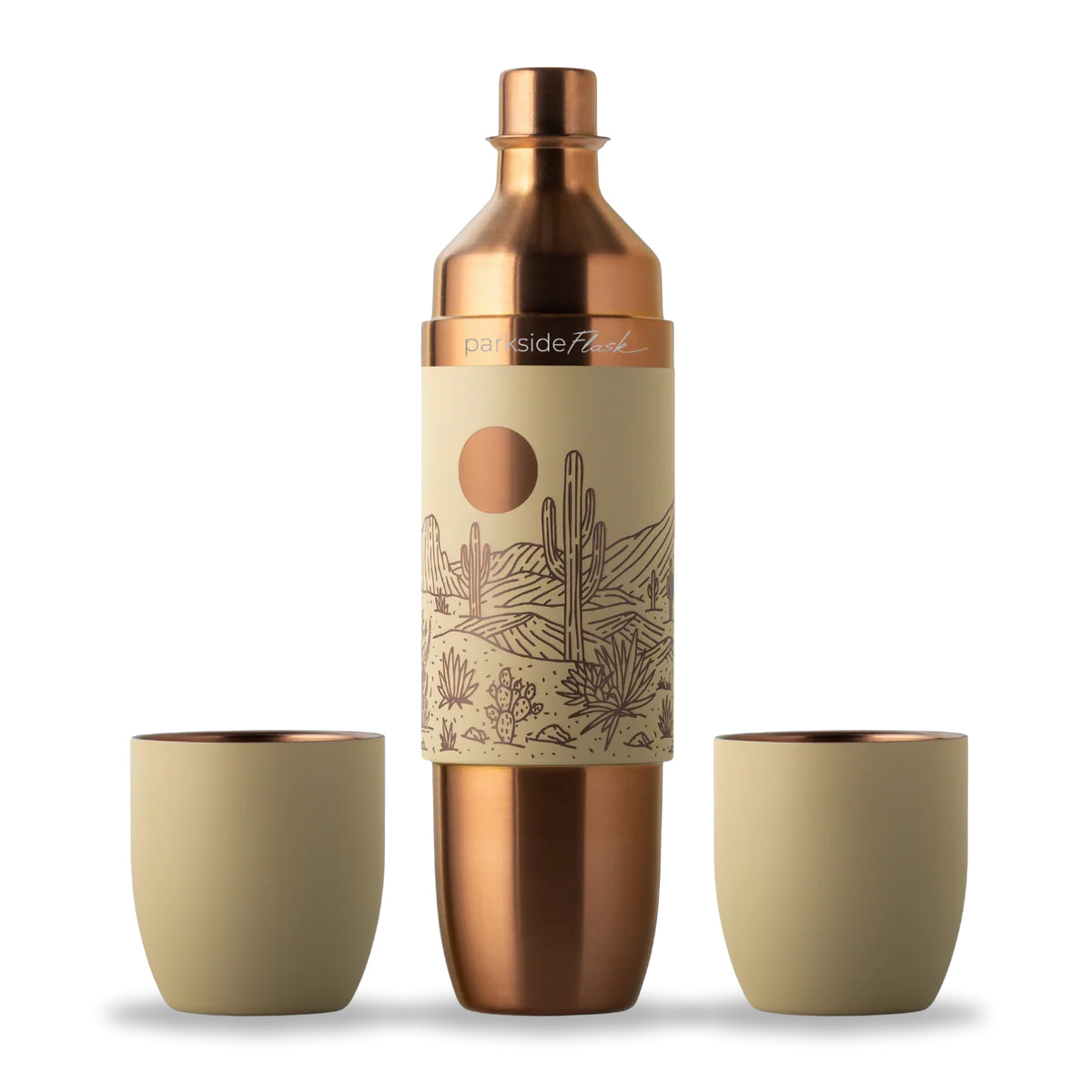
Mikey Rox is an award-winning journalist and LGBT lifestyle expert whose work has published in more than 100 outlets across the world. Connect with him on Instagram @mikeyroxtravels.

